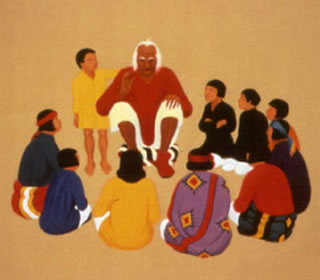On December 21, 2010, here in Nevada City, California at 3:38 PM Pacific Standard Time, 23:38 UTC (Universal Time) winter begins.
This first day of winter is called the Winter Solstice; likewise, the first day of summer is the Summer Solstice. The word solstice is derived from Latin and means “sun standing still.” On this day of the year, the sun’s apparent position in the sky has reached its most southern or northern extreme.
The solstices and the seasons occur because the Earth’s axis is tilted 23.5° relative to its plane of revolution around the sun.
In the Northern Hemisphere winter, the northern half of the globe is tilted away from the sun; therefore, the sun is low in the sky giving us shorter days and longer nights. At this oblique angle, the sun’s energy is spread over a larger area of the Earth’s surface and thus is weaker than if it was hitting the surface more directly. Also, the sun’s rays must travel through more atmosphere before they reach the Earth’s surface, and some of the solar energy is reflected back into space. In addition, there are less daylight hours to warm the Earth.
Contrary to what many believe, the Earth is not farther from the sun during the winter. Actually, the Earth is almost at its closest point to the sun at the time of the northern hemisphere’s Winter Solstice. This variation in the Earth’s distance from the sun is small and does not greatly affect the weather; however it does slightly modify the severity of the Northern Hemisphere winters and summers.
In the Southern Hemisphere, the Winter Solstice takes place on June 21, 2011 at 17:16 UTC (Universal Time). Our Winter Solstice is the southern hemisphere’s Summer Solstice..
Solstice Lunar Eclipse
Not only does the winter solstice of 2010 fall on the day of a full moon, which is a once in 30 years event, but that there will be a total lunar eclipse that night at just about midnight, Pacific time. (The eclipse makes it a 1/400 year sort of event.) A total lunar eclipse occurs when the sun, the Earth and the moon align. The moon is always full and it passes through Earth's umbral shadow, or the darkest part of the shadow.
That shadow is actually composed of two cone-shaped components, one nested inside the other. The outer or penumbral shadow is a zone where the Earth blocks part but not all of the Sun's rays from reaching the Moon. In contrast, the inner or umbral shadow is a region where the Earth blocks all direct sunlight from reaching the Moon.
This is also a time when the sun begins to make its way toward the dark part of the year. The sun's energy, power and dominance is waning, and winter approaching.
In the days which follow, the sun's strength begins to diminish or, in a spiritual sense, descend into the Mother's womb. This continues until the time when the sun's light is reborn at Yule or Winter Solstice, when we celebrate the birth of the Son of Light during a time of spiritual darkness.
Reflect on this sacred time, and notice the season change around you. Watch the Mother Earth tuck her seeds safely within her womb and cover them over with a comforting blanket of earth and fallen leaves and later snowfall. Watch also your animal cousins as they prepare for the approaching winter. Watch the sky and the sacred waters and seas. Listen to the gentle loving promise of the Universe to Mother Earth and all of her children.
"Never fear, our beloved Daughter Earth, for though the sunlight grows faint upon you, the light of the Son will soon return, that all creation may awaken and live again."
So this December 21, remember that even though winter is beginning, and the days will now grow longer and the nights ever shorter; and as we travel through space—around the sun—our Earthly seasons will repeat again and we will now start the journey towards Spring.
Change and be reborn this solstice.










